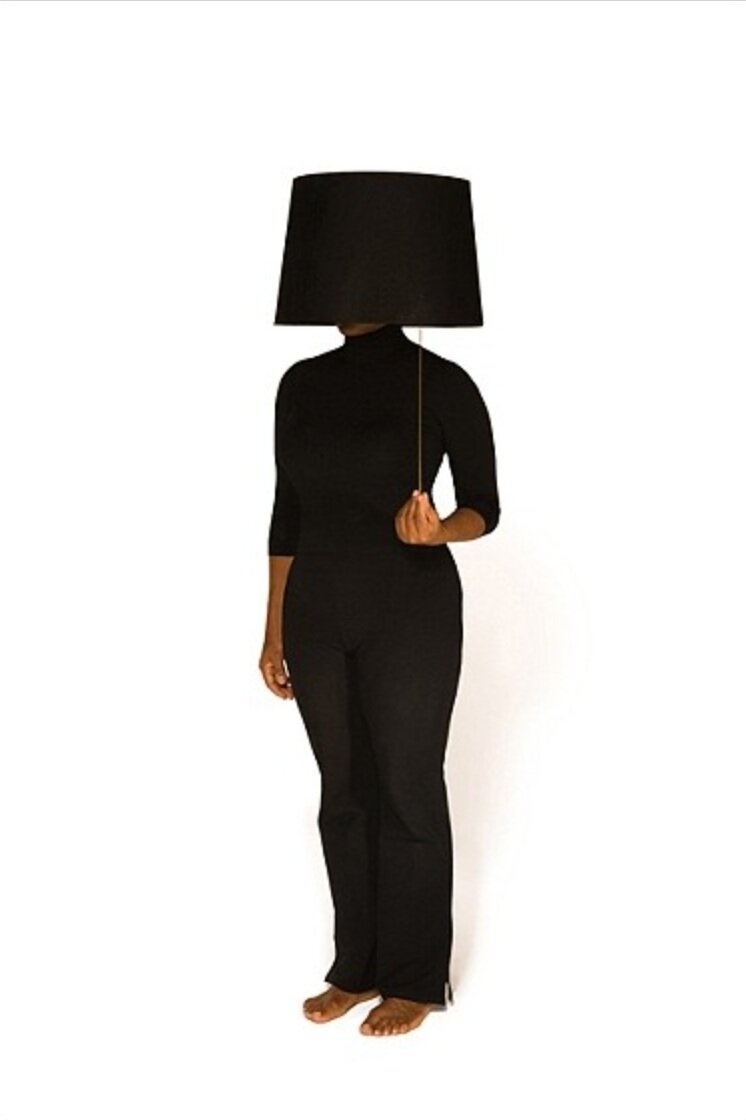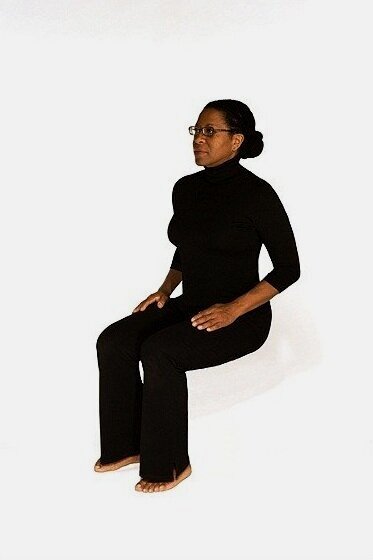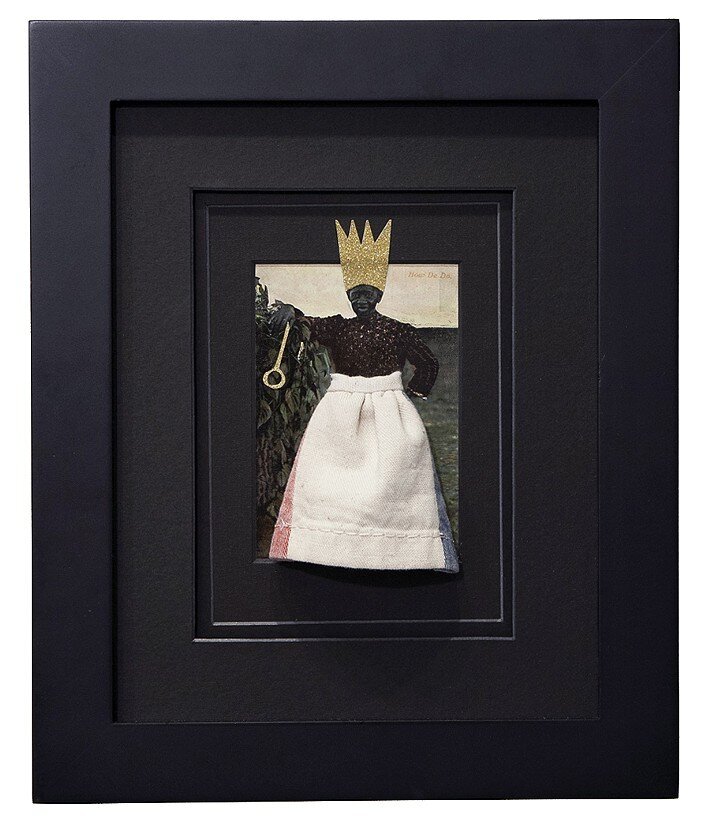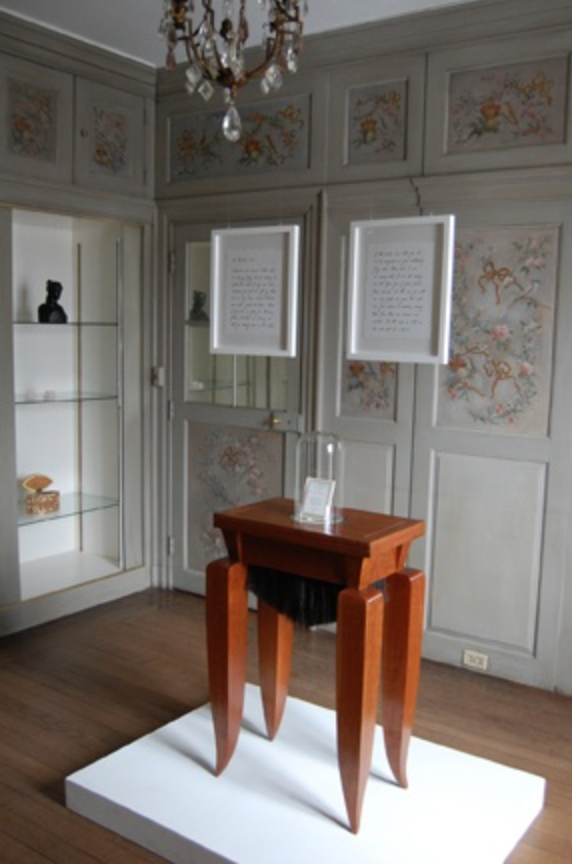The Nappys Revenge Queen Anne
Averill and Bernard Leviton A+D Gallery, Columbia College Chicago, 2011 - 2013
In this work, nappy hair is a symbolic representation of the collective African Diaspora. The cabinet is stuffed with about 100 Afro wigs.The “revenge” on Queen Anne, is the overtaking of the Queen Anne-style curio cabinet as a reprisal on the Kingdom of Great Britain’s first monarch and her rule during the height of the Trans-Atlantic Slave trade.
Construction was curated by Sabina Ott (1955 - 2018) and also included artists: Dawoud Bey, Myra Greene, Melissa Potter, Tao Huang, and Wenhwa Tsao.
Details: Reclaimed curio cabinet, synthetic Afro wigs, wooden crate. 60”h x 33”w x 13”d
Installation photo from 2013 exhibition Construction at the Averill and Bernard Leviton A+D Gallery, Columbia College Chicago..
untitled (#5)
Talking in Tongues Series
Installation view, Averill and Bernhard A+D Gallery, Columbia College Chicago
This series, untitled (#1), untitled (#2), untitled (#3), untitled (#4), and untitled (#5), is made of found objects I have collected over a period of time. Some include sound or video, and the elements are composed in small wooden boxes on metal stands. The works focus on ideas of xenophobia, issues of gender identification, my own theories of harmonic dualism, hair as a symbol of cultural identity, and looking as a way of seeing and assimilating difference.
Looking through the large lens or directly at the video. untitled (#5) offers an opportunity to look and see, to be looked at, as well as to be “seen.”video, 55 sec.
[special thanks to Camille Morgan]
Details: untitled (#5), 2013. Walnut, steel, found glass lens and painted wooden eyes on wire stand, monitor, video.24”h x 14” w x 13”d
Click arrow to hear sample audio in English (2x), Spanish, and Mandarin. (1:31).
Come On (Chair)
Furniture is often a silent partner in the experience of social interaction. We think of chairs, tables, lights, etc., as functional and serviceable objects that help us navigate and embody physical and social space. What if a furniture form itself were to play a more active role in our social interactions? What if it’s role in the social order were more present and participatory?
This unassuming chair sets the stage for a humorous, interactive, multimedia installation that elevates the chair from social object to social participant. Using audio of eight different voices in six different languages (English, French, German, Mandarin, Portuguese, Spanish), this chair seductively solicits the viewer to sit on it and responds through electronic, sensory media.
Details: Found chair, audio speakers, sisal matte, electronic and digital media. 2005
Nesting Chair for Charlie (Yardbird), Sun Ra and the Urban Thrush with Bird Mix
This small work was exhibited at Terrain, an alternative exhibition space in Oak Park, Illinois that uses a front yard for site-specific work by invited artists. The chair, made of found and natural materials has an accompanying sound mix that was broadcast at the site and lives on MixCloud. It includes original recordings, excerpts from interviews and samples from Charlie Parker, SunRa & the SunRa Arkestra, critic Stanley Crouch, Abbey Lincoln and birdcalls of the Urban Thrush.
Details: Branches from Trees, reed, grass, found materials, mixed media and audio (8:57). 54”h x 18”w x 15”d. 2014
Seeing Series: Black Lamp, Black Table, Black Chair
I am curious about how we SEE–how we construct our visual realities and how they are influenced by cultural, social, gender, geographical and intellectual perspectives and biases.
This series of three diptychs looks at the visuality of race and gender and asks: how transparent or opaque are superficial racial signifiers in twenty-first century society? How capable are we as modern citizens of seeing through these identifiers to recognize individual humanity? Are we even aware of the unconscious racial and cultural constructions we impose on others? Has the impact of media, technology, privilege and access to global resources, created a culture with such coded visual vernacular that we take for granted the control our subconscious exercises on much of our collective psyche?
In this work, I built three simplified iconic furniture forms–a lamp, a table and a chair– and documented a "performance" of sorts, portraying myself as those objects. Meant to be humorous, it speaks to serious and unresolved issues of America's racial history and strongly embedded attitudes towards women.
How should one read these images? What responses are solicited by the collision of multiple and potential meanings and representation in body, object, color and gender in a single work? Is black seen as a formal color, a race or a culture? Have women and women of color in particular, indeed risen beyond identities of servitude in society's and our own minds?
This body of work was supported through the generosity of the Anderson Ranch Arts Center in Snowmass Village, Colorado, where I was awarded a residency in the winter of 2006, and a Professional Development Grant from the Rhode Island School of Design.
Photography: Jason Dewey
Details: Black Lamp. Archival digital print. diptych, 40" x 26.6" (ea.), Black table. diptych. 40" x 26.6" (ea.). Archival digital print. Black Chair. Archival digital print. diptych, 40" x 26.6" (ea.)
P.S. I Love You Series
Installation view, Averill and Bernhard Leviton A+D Gallery, Columbia College Chicago
P.S. I Love You is an ongoing series made from found postcards that found their way around the world. They presented romanticized images of African Americans that perpetuated stereotypes of the "happy servant" in the economies of Southern plantation life. The residue of these fictions are still present today. My manipulation of these images is an attempt to rescue African American representation from this debasement. The titles of these pieces are from the original titles found on the postcards..
Details:
Ho De Do, 2013. Found postcard, mixed media. 3-3/8” x 5-3/8”
Sunny Jim. 201. Found postcard, mixed media. 3-1/4” x 4-11/16”
No. 4 Negro Home, 2013. Found postcard, mixed media. 3-7/16” x 4-5/8”
No.7 A Typical Southern Negro, 2013. Found postcard, mixed media.3-7/16” x 4-3/4”
Jezebel's Ch(l)air
Installation view: Museum of Wisconsin Art, Uncommon AdornmentsExhibition, 2011
Hair finds curious residence in some of the furniture forms that I adapt or make and includes work that incorporates hair as both a material and conceptual means of adorning and dressing furniture and other objects. This piece is from a solo show called Uncommon Adornments, and it was recently shown at the Paul Robeson Gallery, Rutgers University in the exhibition Hair.
Jezebel’s ch(l)air, attempts to flirt with the viewer with attitude and sass. The seat is upholstered in shiny black vinyl with rabbit hair trim and is suspended from the ceiling so as to be encountered at eye level.
Details : reclaimed antique French parlor chair, upholstery, hair.
The Kitchen is in the Parlor Now with
untitled (hair)
Installation view: INOVA Gallery, University of Wisconsin Milwaukee
This work has alternatively been installed with a companion video: untitled (hair), 2005.
As a young girl growing up in the fifties, I was often embarrassed to emerge from the kitchen before my mother pressed my nappy hair after washing. Pre-1960s black-is-beautiful standards, required that hair be “tamed” before presenting oneself in public. This works deals with the wrestling many black women have been through to thrive in the Diaspora with their inherent cultural aesthetics healthy and intact.
The form and conceptual basis of this piece plays with language: that of turn-of-the-century parlor furniture, which the form references, and African American vernacular included in the title. The cabinet, veneered in African mahogany with silver inlay and embellishments, opens to reveal a mirrored interior, which is symbolic of both self-reflection and how the viewer sees themselves in relationship to beauty.
The “kitchen” has both literal and symbolic meaning. Literally, it refers to the kitchen as a functional part of the home and domestic site where in a certain time black women gathered to share community and to do their hair. In African American vernacular, it also refers to the back of the neck where you find the nappiest part of the hair and is the hardest area to keep straightened. The long nappy hair that is emerging out of the top of the cabinet claims its place in the parlor–a place of social reckoning and spectacle in 19th and early 20th–century social domestic space.
Details: Mahogany, mahogany veneer, aluminum, steel, mirror, synthetic hair, 2005.
Image 2+3 :Installation view - Museum of Art, Rhode Island School of Design, 2005. In this installation the hair is incorporated into the cabinet's pull and is displayed as an exaggerated, long ponytail.
The Baartman Diaries
Installation view: Villa Terrace Decorative Arts Museum, Milwaukee WI.
Using furniture-based work that include writings and mixed media, I imagine the voice of Sara Baartman, the South African Khoikhoi woman who became known as the “Hottentot Venus” in early 19th-century Europe. Baartman is represented by fictional diary entries that cross time and space and speak to other historical and contemporary figures such as Charles Darwin, the famous 19th-century French naturalist George Cuvier, Josephine Baker and Lil’ Kim. This work seeks to bring to light the ensuing complexity and complicity in the objectification of Black female bodies and the fetishizing of Black female sexuality.
Hottentot Not!, 2008
Cherry, paint, horsetail hair, mirror, bell jar, booklet, fictional diary entry. 5" w x 4" d x 7" h
Baartman was the curiosity of famed French naturalist Georges Cuvier, who upon her death unceremoniously dissected her body, put her brain and genitals in bell jars and used them to support his theories of “Hottentots” as the missing evolutionary link between animals and humans. This piece includes a representation of Cuvier’s famous 1817 treatise: "Extrait d’observations faites sur le cadavre d’une femme connue a Paris et a Londres sous le nom de Venus Hottentote". According to some accounts, Baartman was said to have been made to perform for European audience on a stage and in a cage.
This body of work was generously supported by The Artist in Residence Program at The School of Art + Design at Purchase College in New York, and The Peck School of the Arts at the University of Wisconsin Milwaukee.
Details: Mahogany, mahogany veneer, aluminum, steel, mirror, synthetic hair, 2005.
Image 2+3 :Installation view - Museum of Art, Rhode Island School of Design, 2005. In this installation the hair is incorporated into the cabinet's pull and is displayed as an exaggerated, long ponytail.
Installation view: Richard & Dolly Maass Gallery, Purchase College/SUNY
In this installation, the work is presented in a steel cage reminiscent of the cage Baartman was said to have performed in during the early 1800s for European audiences.
The diary entry reads:
Hottentot not! Indeed!
What shall I call you George Cuvier?
Lusting to explore the secrets of my own dark continent, you pull me off my throne and use my brain, endowed backside, and secret jewels to build a throne of your own in glass jars.
Darwin, Galton, Bertillon and Murray sit with you looking down on the world of the darker ones while you ask us to masquerade in your evolutionary fairy tales.
Hear me! I am no missing link. I am not missing at all!
Your jars of glass preserve false premises.
In the end you will see. My people are good.
We will lead great nations to salvation, rescuing them from their own demise and ruination. In the end, we will see who will call who civilized!
Details: Cherry, paint, horsetail hair, mirror, bell jar, booklet, steel, fictional diary entry. 5" w x 4" d x 7" h
Sara's Lament
This collaboration with my son Dayo Harewood, includes an edit of popular hip-hop music videos showing young black women subjugated to the sexual prowess of male rap artists who portray groups of young women as potential sexual conquests, and also female artists that use their physical gifts for sexual agency and self-exploitation. The diary entry imagines Baartman's point of view on the “curious moving cages” where “video girls” willingly give away their “secrets.” In my research I was influenced by the discovery that in contemporary Nama language, South African women have a collection of secret words that only they share and know the meaning of. These words speak of private, intimate things shared between the women about their romantic world with their husbands and lovers.
Dayo Harewood is a filmmaker based in New York. He graduated from New York University’s Film School and is currently developing a television series called "Plus One", about twenty-something New York City nightlife.
Details: LCD monitors, bell jars, video (30 sec.), fictional diary entries.2008
In the installation, Baartman's ficticious diary entry is positioned above the videos that are displayed in the bell jars. For this piece the diary entry reads:
29 December 1815
"My sisters who hold such precious endowments of luscious curves and obstreperous forms, the ones I see in the curious moving cages that remind me when I was captive to piercing, prying eyes. My dear sisters, why do you give your secrets away so cheaply? Your delicious contours, prominent backsides and dark fruits are meant for a special heart, a special one. Beware! These endowments that you proffer so willingly in these curious moving cages, that cause men to drool like hungry hyenas and blood thirsty jaguars, will wound you in the long run and all women for centuries with lascivious bites in places underneath the skin that will hurt, but do not bleed where you can always see it.
My dear brothers, who parade your women in those curious moving cages triumphantly like Napoleon who wanted to parade soldiers through the L'Arc de Triomphe. You dethrone secret treasures meant only for you and cast them to others like discarded pearls unknowing of their true value. So sadly you live in such a wealth of poverty. Beware! The slave and the slave master can be one of the same."
The Women Wanted Some of Me Too Upholstery
Baartman’s celebrity inspired the 19th-century Victorian bustle dress that evolved stylistically through the entire century. She was one of three south South African women displayed as an anthropological curiosity in Europe during that time with "steatopygia", a so-called condition where proteins are stored as fatty tissue in the posterior and thighs and is common in women who live in arid parts of Southern Africa.
Details: Sapele, 20th-century Ndebele beaded apron, bustle skirt. 24” w x 24” d x 35.5” h. 2008
Oh Josephine
The fictitious diary entry from Baartman in this piece, speaks through time to Josephine Baker and rapper Lil’ Kim. It addresses the women’s complicity in perpetuating myths and untruths about Black female sexuality that continue to effect representations of Black female bodies in contemporary media and popular consciousness.
Details: Found 1920’s typewriter, wooden plinth, fictional diary entry. 15” w x 16” d x 36” h. 2008
This fictional diary entry reads:
29 December 1815
"The one they call the Black Pearl, Her. I don’t understand. They debase me and compare my features, considered beautiful near the Gamtoos, to monkeys and baboons. She who tempts the desires of the Other in both their men and women with bananas around her hips, teasing with the erotic fruit that rests beneath her darkness. Oh don’t displace the love never gained in your homeland for the eyes of the Other that long to taste of your secrets and peer into your darkness to embrace what they imagine they don/t have. Why would you want to boil the water of things that evaporate and leave residues of hideous and repulsive untruths about our bodies, ourselves and how we love? Oh Josephine, you may find fame, riches, and the favor of the powerful Other, but you will not be free from the untruths you perpetuate that our sisters will live with long after you are gone. Celebrate our blackness, not theirs. Our full hips, our voluptuous backsides, strong thighs and secret lips that hold our lovers in delicious embrace. Abandon the savage dance, and the buggy eyes that weave stories of us that aren’t true. You seat us off our thrones and give them cause to justify what they do to us, and others with brown skins.
And when you are in my position, when you can see from the other side, talk to the little one they call Kim. For you, Cuvier, Darwin, Bertillon, Galton, Murray and the like, should ask for her forgiveness. You, not as much as the rest. Yet certainly you know firsthand the pain the little one they call Kim hides under the knife and the jelly she puts inside her chest. How she searches for the throne she has in her closet, but has not yet found the key that opens the door. Tell her to talk to her sisters, the ones in the curious moving cages that remind me when I was captive to piercing, prying eyes, that wanted to see or get between the legs of what they imagined was my dark, juicy continent, who prodded and poked at me in my cage to see if I was real or a figment of their demented imagination. Three pence! Did you see the advertisement Josephine? I’m at least glad you got much, much more!"
Opus 2 in 24 Movements
The work is positioned on a found tripod circa 1950, as a simple box form that contains a DVD player that loops a video (1:07 mins). The video plays an edit and documentation of the activities of my hands over a twenty-four hour period. It can be viewed through three different optical lenses with varying focal lengths from clear to different degrees of distortion.
The top of the box form opens and slides out the back for access to the DVD player. The pull is made of horsetail hair and beads–signature materials in much of my work. The large bead comes from Ghana and is used by weavers from the Ewe tribe. Several hundred pine needles painted with milk paint are emerging from the top.
Details: Found tripod, mahogany, optical lenses, horsetail hair, pine needles, milk paint, beads, DVD player, video. 73 x 38 x 38 in. 2009
A still from the video within the piece which was shot and edited by my collaborator and son, Dayo Harewood, a filmmaker in New York. The still shown is actually of me making the work.
Dayo's companion essay to mine from the exhibition catalog:
It is not a total surprise that I find myself collaborating on creative projects with other artists. I consider myself a filmmaker first and foremost. In my role as director I visualize a shot, a theme, an emotion, a mood, and a message. To realize and fulfill my complete vision, it is necessary to hear the voices of the creative team around me, whether it be a set designer, wardrobe stylist or director of photography.
With this project, I’m lucky to be able to join my voice and creativity with the person whose life and vigor has inspired me the most: my mother, Fo Wilson. Most of my inclination toward creative art stems from her example and confidence. The arts have also been one of the avenues for which we have always been able to share and communicate freely.
Through this project I have been able to grab a deeper perspective on her process and her design philosophy and the importance she places on craft versus design in the process of creating. This philosophy was not immediately tangible to me while shooting and editing this piece for our collaborative installation, but became apparent as I reflected on my own process. I start with a vision for what I want to communicate, but as I mold the piece through editing, it transforms, becoming something new and informed by the process itself.
Burning Chair (apologies to Larry Harvey*)
This work is an investigation into the materiality of a chair. A poplar frame was wrapped with rebar wire then burned in an outdoor pit. The remains were exhibited along with video documentation.
*Larry Harvey is the founder and producer of Burning Man, an annual art festival that takes place in the Black Rock Desert of Nevada, where on the final day a giant man-like effigy is burned.
Details: Burnt poplar, rebar and video. 2004
Nests I & II
Nests create their own little worlds and spaces for comfort and nurturing. Although large (these pieces are about eight feet tall), they have small openings where one can glimpse a micro view of a larger world, where in a moment one can have a simple experience of a natural environment.
Details: Cherry and willow reed. 2004



































